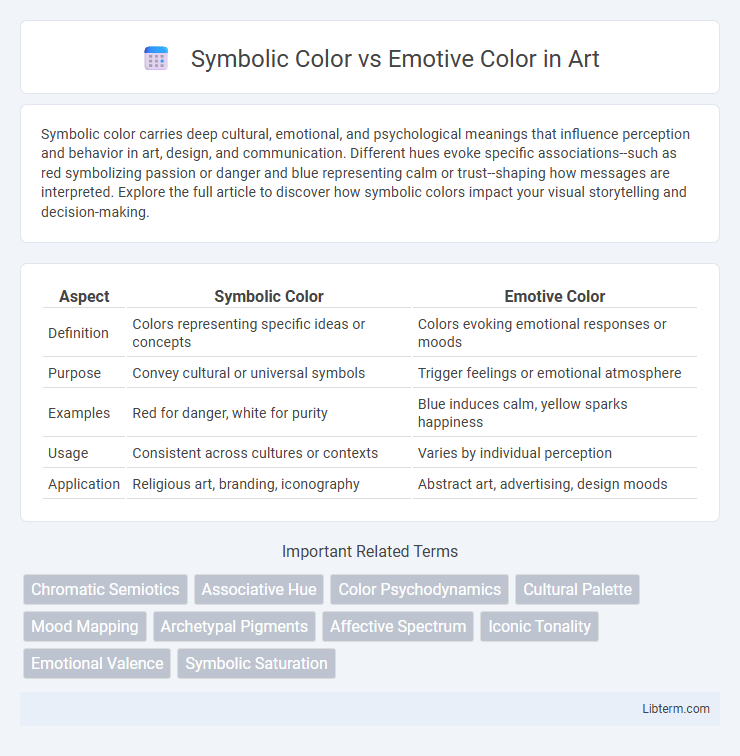Symbolic color carries deep cultural, emotional, and psychological meanings that influence perception and behavior in art, design, and communication. Different hues evoke specific associations--such as red symbolizing passion or danger and blue representing calm or trust--shaping how messages are interpreted. Explore the full article to discover how symbolic colors impact your visual storytelling and decision-making.
Table of Comparison
| Aspect | Symbolic Color | Emotive Color |
|---|---|---|
| Definition | Colors representing specific ideas or concepts | Colors evoking emotional responses or moods |
| Purpose | Convey cultural or universal symbols | Trigger feelings or emotional atmosphere |
| Examples | Red for danger, white for purity | Blue induces calm, yellow sparks happiness |
| Usage | Consistent across cultures or contexts | Varies by individual perception |
| Application | Religious art, branding, iconography | Abstract art, advertising, design moods |
Understanding Symbolic Color: Meanings Across Cultures
Symbolic color conveys specific meanings deeply rooted in cultural traditions, such as red symbolizing luck in China and mourning in South Africa. These colors function as visual codes that communicate societal values, beliefs, and rituals without words. Understanding symbolic color requires examining historical context and cross-cultural differences to accurately interpret its intended message in art, design, and communication.
The Power of Emotive Color: Influencing Mood and Perception
Emotive color plays a crucial role in shaping mood and perception by eliciting psychological and physiological responses that influence human behavior and decision-making. Unlike symbolic color, which conveys fixed cultural meanings, emotive color taps into subconscious feelings, using hues like red to evoke excitement or blue to instill calmness, ultimately affecting emotional states and interpersonal interactions. Marketing strategies and interior designs leverage emotive color to create specific atmospheres that enhance user experience and engagement.
Key Differences Between Symbolic and Emotive Color
Symbolic color represents cultural or societal meanings, such as red signifying danger or love, whereas emotive color evokes instinctual emotional responses independent of cultural context. Symbolic color relies on learned associations and varies across different cultures, while emotive color triggers universal feelings like calmness from blue or excitement from yellow. Understanding these distinctions is crucial for effective visual communication and color psychology application in marketing, design, and art.
The Psychology Behind Symbolic Color Choices
Symbolic color choices are deeply rooted in cultural, religious, and historical contexts, where colors like red signify power or danger and white represents purity or peace. Emotive colors, in contrast, directly evoke emotional responses such as calmness from blue or excitement from yellow due to psychological associations. Understanding the psychology behind symbolic color helps marketers and designers craft messages that resonate with target audiences by leveraging culturally ingrained meanings and emotional triggers.
Emotional Impact: How Emotive Color Shapes Experience
Emotive color profoundly shapes user experience by evoking specific feelings and moods through its psychological impact, such as red stimulating energy and passion while blue induces calmness and trust. Unlike symbolic color, which conveys culturally or universally recognized meanings like green representing nature or safety, emotive color directly influences emotional responses and behavior in design and art. Understanding how emotive color manipulates perception helps creators craft environments and visuals that engage audiences more effectively by aligning colors with desired emotional outcomes.
Symbolic Color in Art and Design
Symbolic color in art and design leverages culturally and historically established meanings to convey messages and evoke specific interpretations. Colors such as red often symbolize passion or danger, while blue can represent calmness or spirituality, enabling artists and designers to communicate complex ideas without words. Understanding the symbolic significance of colors enhances the depth and effectiveness of visual storytelling in creative works.
Emotive Color in Branding and Marketing
Emotive color in branding and marketing directly influences consumer emotions and psychological responses, enhancing brand recognition and loyalty by triggering specific feelings such as trust, excitement, or calm. Unlike symbolic color, which conveys culturally embedded meanings, emotive color targets the subconscious to create immediate emotional connections, impacting purchasing decisions effectively. Strategic use of emotive color, like red for urgency or blue for reliability, can elevate brand perception and drive consumer engagement in competitive markets.
Cultural Contexts: Symbolic vs. Emotive Color Across the Globe
Symbolic colors carry specific meanings rooted in cultural traditions, such as red symbolizing luck in China or mourning in South Africa. Emotive colors evoke universal psychological responses like calming blues or energizing yellows, yet their intensity can vary across cultures based on collective experiences. Understanding the cultural context enhances communication by aligning symbolic interpretations with emotional reactions to color in global design and marketing strategies.
Practical Applications: When to Use Symbolic or Emotive Color
Symbolic color is ideal for branding and cultural communication, where specific hues represent universal ideas, such as red for warning or green for safety, ensuring clear and consistent messages. Emotive color is best used in marketing and design to evoke psychological responses, like blue promoting calmness or yellow inspiring optimism, enhancing consumer engagement. Practical application depends on the goal: use symbolic colors to convey clear meanings and emotive colors to influence feelings and behavior.
Harmonizing Symbolic and Emotive Color in Visual Communication
Harmonizing symbolic and emotive color in visual communication creates a powerful narrative by blending culturally recognized meanings with instinctual emotional responses. Strategic use of color palettes that respect symbolic significance while evoking targeted emotions enhances brand identity and user experience. Integrating tools like color psychology charts and cultural color codes ensures designs resonate deeply across diverse audiences.
Symbolic Color Infographic

 libterm.com
libterm.com